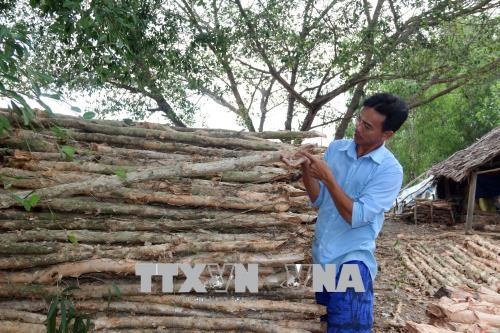 Society
Society

Many poor households that were given cajeput forests to protect and harvest as part of a local programme in Kiên Giang Province have escaped poverty.
 |
| Many households in Forest Unit Area No 34 in Kiên Giang Province’s An Minh District have higher incomes now because of the rising prices of cajeput trees they are tasked to protect by local authorities. — VNA/VNS Photo Lê Sen |
HCM CITY — Many poor households that were given cajeput forests to protect and harvest as part of a local programme in Kiên Giang Province have escaped poverty.
Located in Cán Giáo Hamlet in An Minh District’s Đông Hưng B Commune, the Forest Unit Area No 34 has more than 1,290ha of cajeput forests which have been allocated to poor households to protect since 2009.
Võ Văn Thạch, one of the first farmers given a forested area, said that, besides money from selling cajeput trees, his family now earns an average additional income of VNĐ60 million (US$2,600) a year from selling honey, fish and vegetables.
Households who protect forests are allowed to harvest 10 per cent of allocated forests a year and have to replant new forests in the harvested area, he said.
When forest-allocated households moved in the area, they were all poor and lived in temporarily thatch-roofed houses, he said.
The area did not have electricity or roads at the time, and there were plenty of mosquitoes.
The low prices of cajeput yielded little income, but the price has increased significantly since 2016.
The price is now VNĐ15-20 million ($660 -880) per 1,000sq.m compared to VNĐ3 million per 1,000sq.m in 2009. Traders come directly to forests to buy the trees.
After harvest, more households are planting new cajeput forests.
No fires have broken out as farmers were also asked to ensure protection for the area from fire.
Besides planting forests, the households breed fish, plant vegetables and lure bees to build hives in their forests to collect honey.
With the income, many household have built houses and bought enough house facilities for their daily lives in recent years.
Trần Phi Hải, deputy director of the Forest Protection Board of An Biên and An Minh districts, said under the policy of the provincial People’s Committee on allocating cajeput forests for poor households to protect, 142 poor households who lived near the Forest Unit Area No 34 and did not have farmland for production were allocated forests for protection in 2009.
Each household was allocated an average of 5ha and allowed to harvest 10 per cent of allocated cajeput forests a year, he said.
The allocated forests were 10 years old at that time.
Quách Thị Diệp, one of the forest-allocated households, said previously she was very poor and had to work as a daily hired labourer or a peddler to earn a living.
Thanks to the policy, she now has a stable life, and has built a new house in the area.
Similarly, Tôn Văn Rỏi, one of the households in the programme, now has a house and stable income.
Besides harvesting cajeput forests and replanting new forests every year according to regulations, Rỏi breeds fish, plants vegetables and collects honey to improve income, he said.
He also works an additional job as a cajeput trader to earn more income.
Since 2017, the Forest Unit Area No 34 has had access to the national power grid.
Nguyễn Thành Công, a secretary for Cán Giáo Hamlet, said the lives of the households in Forest Unit Area No 34 had improved significantly.
Only 60 households in the area are still considered poor, he said. — VNS